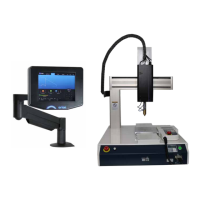13
AGITATION
During the weld, a high frequency agitation feature can be used to improve weld formation and strength.
Additional energy is added to the weld in the form of micro energy bursts. ese energy bursts occur at a
rate of up to 600 times per second. Using agitation can produce an audible, high-pitched “ping” noise.
NONE With “None” selected, no agitation is added to the weld. is is the standard weld discharge curve
with a smooth slope.
SLOPED e Sloped agitation option offers low levels of agitation. It has minimal impact on spot size
formation, but yields additional penetration and enhanced weld strength.
SUSTAINED e Sustained option offers high levels of agitation for improved weld spot strength in some
metals. e high levels of agitation energy will affect the spot size because of the extra energy used in this
option. To compensate for this addition of agitation energy, it’s recommended to lower the overall weld
energy slightly when using this option.
*Sloped and Sustained Agitation can increase weld penetration with minimal effect to the size of the heat
affected zone. Enabling these can make a big difference in weld outcomes, so exercise caution.
LENGTH
Length adjusts the amount of time that the energy is discharged from the welder. In classic waveform
mode, the length will automatically adjust to the recommended time as the users adjust the power dial. In
the Triangle and Square waveform mode, the length will not adjust automatically. Users will set the length
and power independently in Triangle and Square waveform modes. Increasing or decreasing Length allows
for more or less total weld energy and will change the size and penetration of the weld spots.
WELD DISCHARGE SHAPE
After choosing the waveform, agitation, ignition, length and power you will have a weld discharge shape.
is shape is displayed on the screen in the blue section. As you adjust those 5 parameters the weld
discharge shape will change. e weld discharge shape and energy can be adjusted to fit the needs of
the metals being welded as needed. It is often best to start at a low energy with maximum length and no
agitation, then add energy in small increments as needed. Changing weld length will help fine tune the
results.

